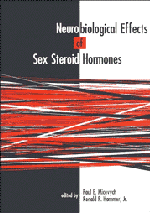Book contents
- Frontmatter
- Contents
- List of contributors
- Dedication
- Preface
- Acknowledgments
- Part I Sex steroid–responsive circuits regulating male and female reproductive behaviors
- Part II Sex steroid interactions with specific neurochemical circuits
- 5 Ovarian steroid interactions with hypothalamic oxytocin circuits involved in reproductive behavior
- 6 Sex steroid regulation of hypothalamic opioid function
- 7 Effects of sex steroids on the cholecystokinin circuit modulating reproductive behavior
- 8 Cholinergic regulation of female sexual behavior
- 9 Sex steroid regulation of tachykinin peptides in neuronal circuitry mediating reproductive functions
- 10 Dopaminergic influences on male rat sexual behavior
- 11 Studying neurotransmitter systems to understand the development and function of sex differences in the brain: the case of vasopressin
- Part III Cellular and molecular mechanisms regulated by sex steroids
- Index
5 - Ovarian steroid interactions with hypothalamic oxytocin circuits involved in reproductive behavior
Published online by Cambridge University Press: 15 October 2009
- Frontmatter
- Contents
- List of contributors
- Dedication
- Preface
- Acknowledgments
- Part I Sex steroid–responsive circuits regulating male and female reproductive behaviors
- Part II Sex steroid interactions with specific neurochemical circuits
- 5 Ovarian steroid interactions with hypothalamic oxytocin circuits involved in reproductive behavior
- 6 Sex steroid regulation of hypothalamic opioid function
- 7 Effects of sex steroids on the cholecystokinin circuit modulating reproductive behavior
- 8 Cholinergic regulation of female sexual behavior
- 9 Sex steroid regulation of tachykinin peptides in neuronal circuitry mediating reproductive functions
- 10 Dopaminergic influences on male rat sexual behavior
- 11 Studying neurotransmitter systems to understand the development and function of sex differences in the brain: the case of vasopressin
- Part III Cellular and molecular mechanisms regulated by sex steroids
- Index
Summary
Introduction
Circulating gonadal and adrenal steroid hormones readily cross the blood–brain barrier and affect neural circuits that subserve various aspects of brain function and behavior. When investigating the interactions between hormones and neurotransmitter systems, it is particularly important to study a model system where there is a behavioral endpoint for which the neural control sites are discrete and accessible. Mating behavior in the female rat provides such a system (Pfaff 1980). The ovarian steroid hormones estradiol (E) and progesterone (P) synchronize the occurrence of mating and ovulation, and thereby increase the likelihood of reproductive success. Our goal is to take advantage of this useful model system in order to elucidate the mechanisms of steroid hormone action on neuronal activity and connectivity. In addition to enhancing our knowledge of the specific events that control this biologically important behavior, such studies may have broader implications for the analysis of hormone–neurotransmitter interactions.
It is well known that ovariectomized (OVX) female rats display very little sexual behavior. Estradiol replacement reverses this condition, however, by sensitizing specific neural circuits to stimuli that elicit sexual behavior. Approximately 48 hours after E is administered, OVX female rats display sexual behavior when they encounter a male. Progesterone treatment, given after E and about 4 hours before behavioral testing, further enhances female sexual behavior (Boling and Blandau 1939). Treatment with P is ineffective unless the animals have been primed with E, in part because E induces expression of a subset of P receptors (MacLusky and McEwen 1978).
- Type
- Chapter
- Information
- Neurobiological Effects of Sex Steroid Hormones , pp. 117 - 142Publisher: Cambridge University PressPrint publication year: 1995



